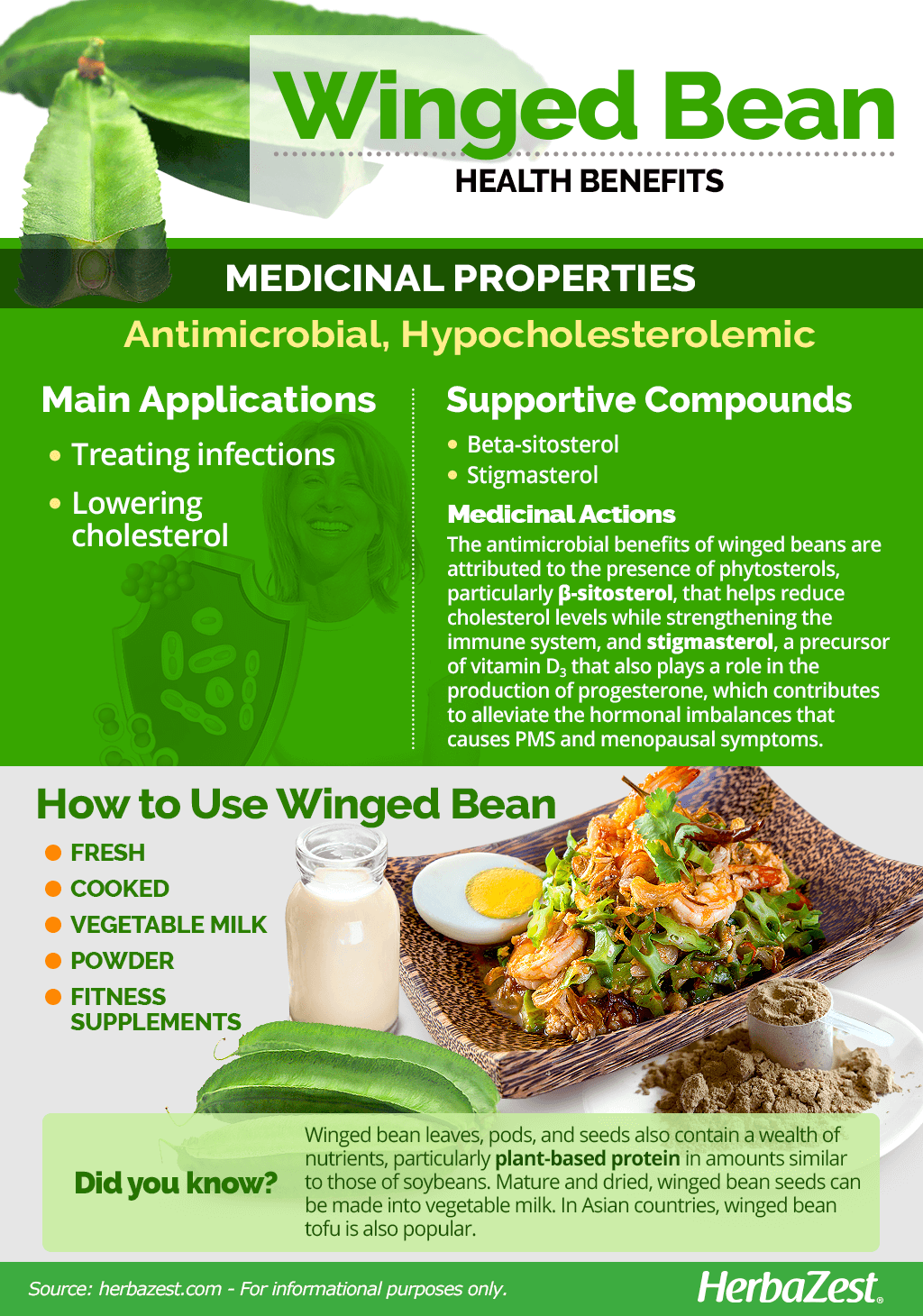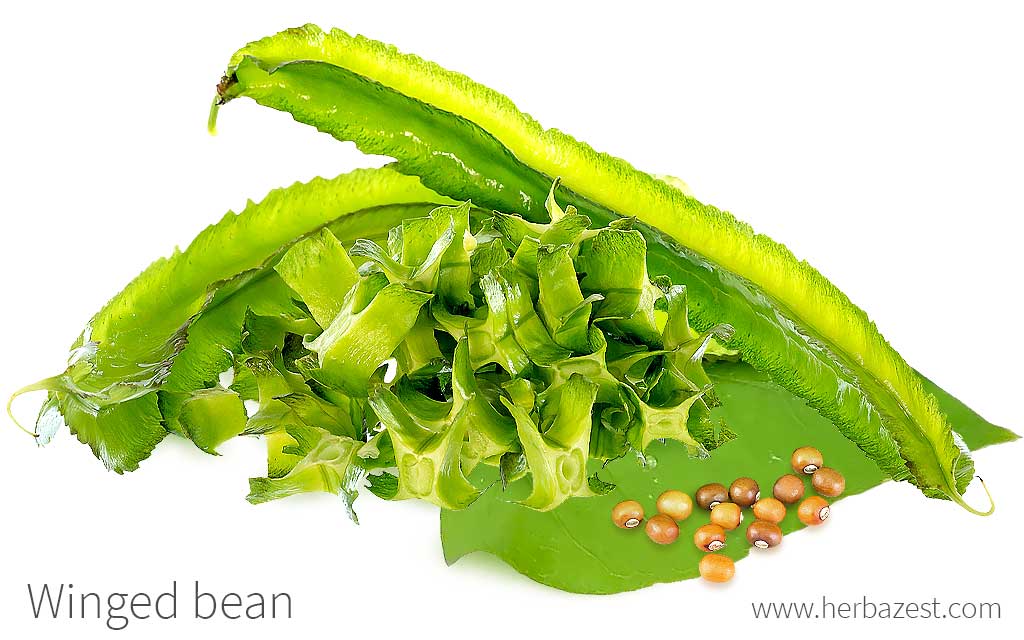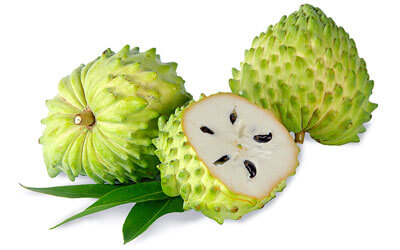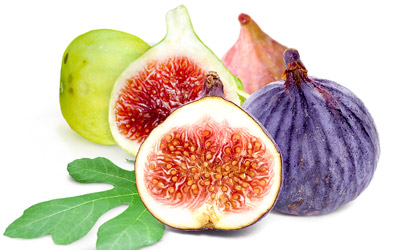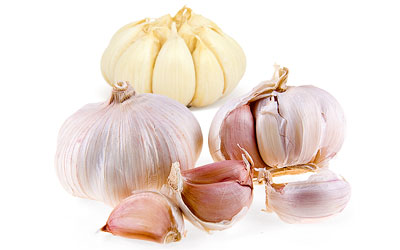Winged bean is native to Southeast Asia, specifically New Guinea, Myanmar, and India. This nutritious legume has been so widely domesticated that it can't be found growing naturally in the wild anymore. Although it has yet to be well-known outside of its native regions, its extremely high nutritional content and health benefits make it a valuable crop.
Winged Bean Medicinal Properties
Health Benefits of Winged Bean
Winged bean is not a popular food, and little research has been performed on its use for human consumption. However, some studies have found that it has valuable medicinal properties, including:
Treating infections. Winged bean has significant antimicrobial properties that can inhibit the growth of fungi and bacteria.
Lowering cholesterol. Eating winged bean has been shown to lower the incidence of bad cholesterol in the blood.
Winged bean also contains a wealth of vitamins and nutrients that make it a highly nutritious addition to any diet. These components may provide winged bean with the ability to help boost immune system activity, strengthen bones, and promote eye health.
How It Works
The antimicrobial benefits of winged bean are not yet fully understood, as the plant has not been extensively studied. However, in an in vitro assay, extracts from winged bean's roots, stems, leaves, and particularly the pod of the plant have shown strong antimicrobial activity against 19 microbial species, including 11 bacterial pathogens, four yeasts, and four molds.1,2
Winged bean's fatty oil is mainly constituted of two phytosterols: stigmasterol and β-sitosterol.3 Stigmasterol is not only a precursor of vitamin D3, but also plays a role in the production of progesterone, which is an important hormone that regulates estrogen's effects. β-sitosterol helps reduce cholesterol levels while strengthening the immune system. The combination of both offers powerful defense against heart disease and common viruses (i.e., cold and flu), and it can even contribute to easing menopause symptoms.
Winged Bean Side Effects
Beyond its nutritional advantages as part of a healthy diet, very little research has been done on the medicinal applications of winged bean. Hence, there is no record of side effects caused by consuming it.
Winged Bean Cautions
Winged bean has no known medical interactions. However, it may cause an allergic reaction, including rash or anaphylaxis, in those who are sensitive to legumes. It should also be avoided by those with G6PD-enzyme deficiency disease.
In any case, due to the lack of studies to corroborate its benefits or assess its safety, it is advised to consult a health professional before consuming winged been in medicinal doses.
- Medicinal action Antimicrobial, Hypocholesterolemic
- Key constituents Beta-sitosterol, stigmasterol
- Ways to use Food, Powder, Dried
- Medicinal rating (1) Very minor uses
- Safety ranking Safety undetermined
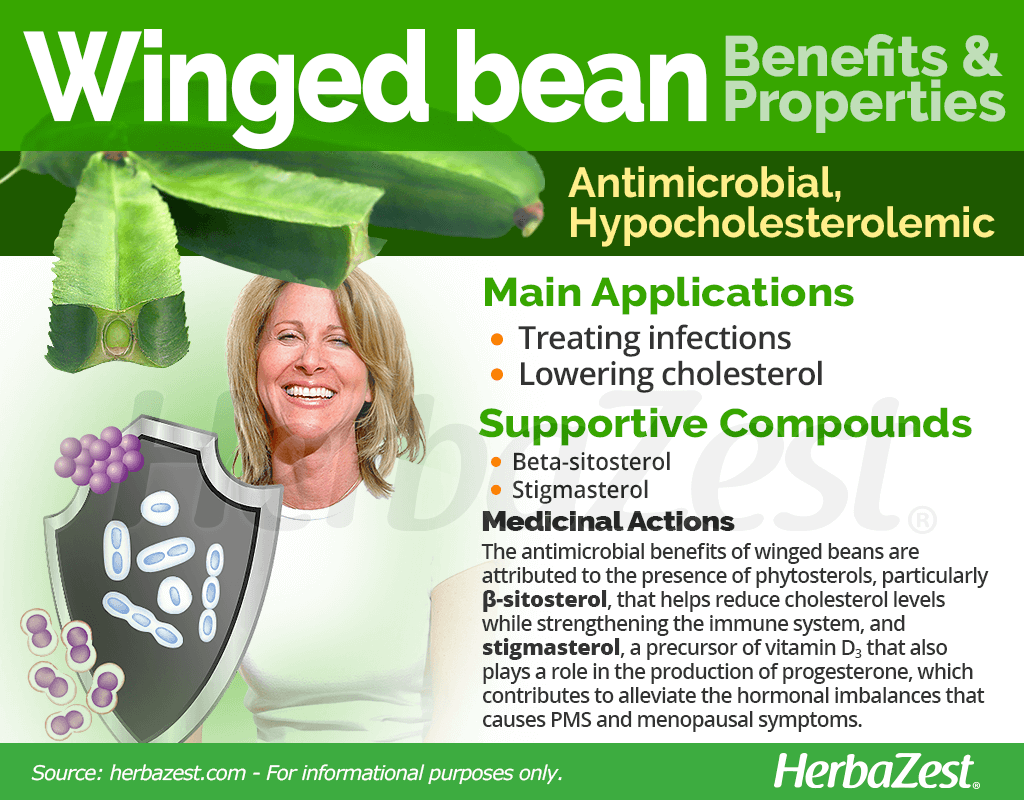
Winged Bean Nutrition
All the aereal parts of the winged bean plant are edible and provide nutritional benefits. However, the underrated, not widely known winged bean's dry seeds are more commercialized outside of Asia and incredibley rich in essential vitamins and minerals.
Winged bean's seeds are a great source of vegan protein, in amounts that rival the ones of soy. They also provide high levels of dietary fiber.
Mature winged bean's seeds are a powerhouse of nutrients, particularly copper, an essential trace mineral crucial for brain development as well as for the immune and nervous systems, healthy blood vessels, energy production, and the regeneration of connective tissue. Another mineral abundant in winged bean seeds is manganese, which is essential for energy production and cellular integrity as well as for a healthy immune system, strong bones, reproductive function, and blood clotting. Iron, necessary for red blood cells production, is also present in high amounts in winged bean seeds, along with good amounts of calcium, magnesium, phosphorus and zinc.
In the vitamins' department winged bean's mature seeds provide a good deal of nutrition from the B group, mainly from B1 (thiamin) and B2 (riboflavin), both of which are essential in metabolic processes, from eye health and energy production to breakdown of carbohydrates and fatty acids.
The nutritional profile of winged bean's mature seeds is rounded by good amounts of other minerals and vitamins, including potassium, selenium, and B3 (niacin) as well as small quantities of B5 (pantothenic acid) and B9 (folate).
100 grams of mature winged bean's seeds, cooked, provide 147 calories, composed by 21%DV of protein, 9%DV of healthy fats, 5%DV of complex carbohydrates, and about 17%DV of dietary fiber.
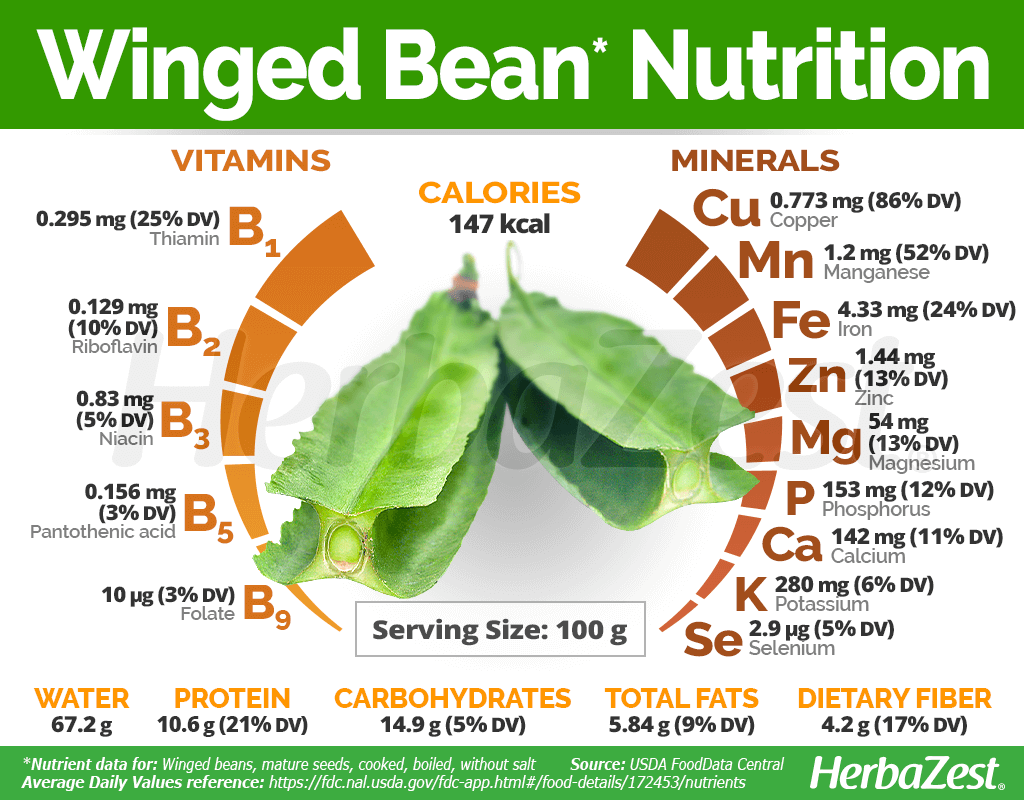
How to Consume Winged Bean
Winged bean is an underrated legume, not well-known in most regions of the world, but it is popular in many parts of Southeast Asia, where it is more widely cultivated. Every part of the plant is edible; the seeds, leaves, shoots, and flowers can all be eaten and provide many vitamins, as well as other nutrients. Winged bean is especially popular because it is an excellent source of protein.
It is most common for winged beans to be eaten in Myanmar and New Guinea, where they are cultivated.
Natural forms
Fresh. With a slightly sweet flavor, similar to that of asparagus, winged bean's leaves, shoots, and flowers can be consumed in salads.
Cooked. The green pods can be sautéed like any other vegetable, whereas winged bean seeds (immature or mature) can be cooked in different forms, most commonly steamed, boiled, fried, and roasted.
Vegetable milk. Mature, dried winged bean seeds can be made into milk in the same fashion as soybeans. In Asian countries, winged bean tofu is also popular.
Powder. Winged bean leaves are also consumed as a powder to be added to curries or nutritional shakes.
Herbal Remedies & Supplements
Fitness supplements. The isolated protein powder from winged bean seeds can be found in many health supplements, especially the kind taken by vegans and athletes to help build body mass and aid muscle recovery.
- Edible parts Flowers, Fruit, Leaves, Root, Stem
- Edible uses Protein
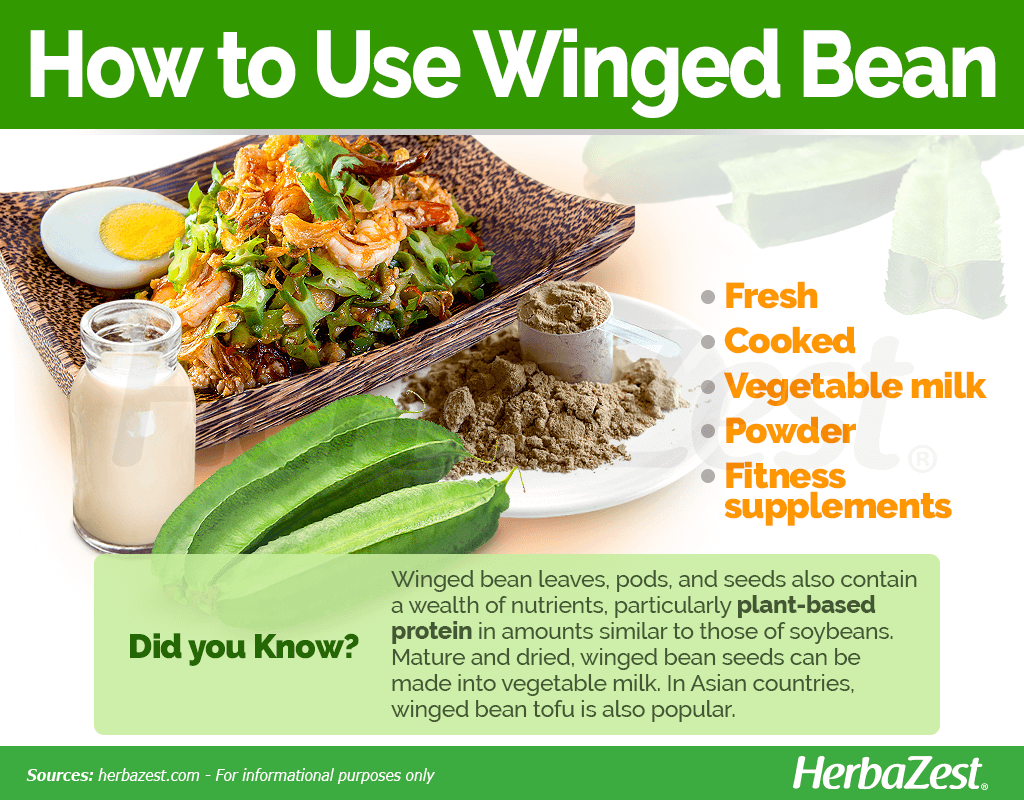
Growing
Winged bean requires some specific conditions in order to thrive, but if those conditions can be met, it is a rewarding plant to grow for its many health benefits.
Growing Guidelines
Winged bean is generally propagated either by seed or by tuber, although seeds are significantly more common.
Several soil types can support winged bean growth as long as they are well-drained and fertile, with a pH level above 5.5.
Seeds or tubers should be planted one inch (2.5 cm) deep approximately two feet (60 cm) apart in rows.
Winged bean requires at least 40 inches (1,000 mm) of rain per year, but it cannot survive waterlogging.
The plant is very sensitive to the cold, and it grows best in equatorial regions with day temperatures between 77 - 90°F (25 - 32°C) and night temperatures above 64°F (18°C).
Winged bean is generally ready for harvest 10 weeks after sowing. The plant produces new pods continuously and should be harvested approximately once per week.
Winged bean can suppress weed growth and improve nitrogen content of soil where it is grown.
There are no major diseases or pests that attack winged bean, although it may be infested by mites and aphids, and fungal diseases like powdery mildew and rust are possible.
More detailed information about growing winged bean can be found in the herb garden section.
- Life cycle Perennial
- Harvested parts Flowers, Seeds, Leaves, Fruit, Bulb
- Light requirements Full sun
- Soil Well-drained
- Soil pH 5.6 – 6.0 (Moderately acidic), 6.1 – 6.5 (Slightly acidic), 6.6 – 7.3 (Neutral), 7.4 – 7.8 (Slightly alkaline), 7.9 – 8.4 (Moderately alkaline), 8.5 – 9.0 (Strongly alkaline), > 9.0 (Very strongly alkaline)
- Growing habitat Tropical regions, Warm climates
- Pre-germination seed treatment Scarification, Soaking
- Planting time Early spring, Spring
- Plant spacing average 0.6 m (1.97 ft)
- Potential insect pests Aphids, Mites
- Potential diseases Rust, Powdery mildew
Additional Information
Plant Biology
Winged bean is a perennial plant that is generally climbing or twining and may grow up to 13 feet (4 m). It has numerous roots that usually remain at a shallow depth in the soil. Its leaves are oval- to triangular-shaped and can grow up to six inches (15 cm) long. Its flowers are usually blue to purple, but may also be nearly white or a dark reddish-purple. The pods have four sides, but the length and shape of the pods may differ among different varieties.
Winged bean may also be referred to as Goa bean, princess bean, asparagus pea, four-angled bean, or Manila bean.
Classification
Winged bean, or Psophocarpus tetragonolobus, is a member of the Fabaceae family. This family is known as the legume, pea, and bean family, and it is one of the largest plant families in existence, with over 19,000 species, including many of great economical importance, like alfalfa (Medicago sativa), carob (Ceratonia siliqua), pea (Pisum sativum), bean (Phaseolus vulgaris), chickpea (Cicer arietinum), lentil (Lens culinaris), lupin (Lupinus spp.), peanut (Arachis hypogaea) and soybean (Glycine max).
Related Species
P. tetragonolobus has approximately 10 closely-related species that are also members of the genus Psophocarpus. All of these plants are native to Africa; P. tetragonolobus is the only member of the genus to grow natively in Southeast Asia.
Historical Information
The history of winged bean is unclear. The exotic legume was first noted by European explorers in the 17th century in the Moluccas islands, where it was possibly introduced by the Arabs from the African side of the Indian Ocean. Although winged bean is not a popular plant outside Southeast Asia, where no wild specimens exist, scientists have determined it to be one of the most underutilized legumes, especially considering its nutritional profile.
Other Uses
Fodder. Winged beans are also be used to feed cattle, as it is a low-cost protein and contains many vital nutrients for animals.
Fuel. It has been suggested that winged bean seed oil can be a substitute for soybean oil, as well as an alternative source for ethanol fuel, although the potential for these applications has yet to be determined, and further studies are needed.
Despite the low profile winged bean has worldwide, it is a highly nutritious plant with several potential health benefits, making it an excellent addition to a balanced diet.
- Other uses Animal feed
Sources
- Grassland: Quietness and Strength for a New American Agriculture, p. 229
- Handbook of Vegetable Science and Technology, pp. 485 - 489
- Journal of Food Science and Technology, Physicochemical analysis of Psophocarpus tetragonolobus (L.) DC seeds with fatty acids and total lipids compositions, 2015
- Pharmaceutical Biology, Fungicidal Effect and Oral Acute Toxicity of Psophocarpus tetragonolobus. Root Extract, 2008
- The Cambridge world history of food, p. 1157
- The Cultural History of Plants, p. 148
- University of Hawaii, College of Tropical Agriculture and Human Resources, Winged Bean
- Vegetables, pp. 435 - 438
- World Oilseeds, pp. 465 - 475
Footnotes:
- Foodborne Pathogens and Disease. (2008). Antimicrobial activities of Psophocarpus tetragonolobus (L.) DC extracts. Retrieved October 30, 2023, from: https://pubmed.ncbi.nlm.nih.gov/18767977/
- Plants (Basel). (2020). Psophocarpus tetragonolobus: An Underused Species with Multiple Potential Uses. Retrieved October 30, 2023, from: https://www.ncbi.nlm.nih.gov/pmc/articles/PMC7762608/
- Journal of Food Science and Technology. (2015). Physicochemical analysis of Psophocarpus tetragonolobus (L.) DC seeds with fatty acids and total lipids compositions. Retrieved October 30, 2023, from: https://www.ncbi.nlm.nih.gov/pmc/articles/PMC4444922/
